Expedition to Azerbaijan 2013
All travel reports are translated electronically although minor improvements are sometimes made.
Expedition to Azerbaijan 2013
The route of my Azerbaijan trip: border crossing on the route Lagodekhi – Balaken, Balaken, Zaqatala, Seki, transit through Ismayili, Lahic, Baku, Tours from Baku (Qobustan, Fire Temple, Petroglyphs, Mud volcanoes), Quba, Xinaliq, Quba, Baku, Krasny Most .
The border between Georgia and Azerbaijan
On the Lagodekhi (Georgia) – Balakan (Azerbaijan) route, there is a border between the two countries. From the village of Lagodekhi I drove to the border hitchhiking for about 5km. I ate my last breakfast in Georgia with a dog and then went to cross the new border. I admit that it went pretty smoothly but the uniform twice asked me if I was in Armenia for what I said “no” because for that moment I have not had time to go there.
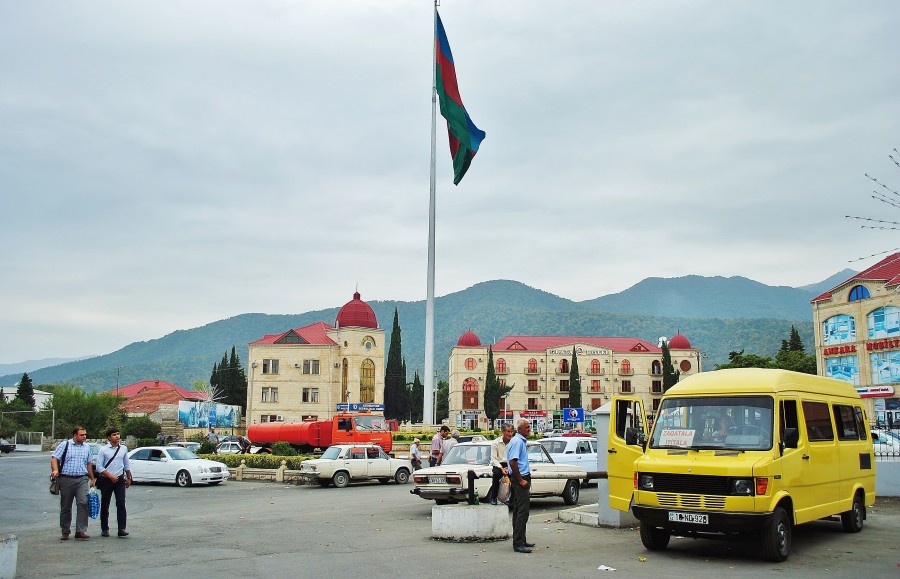
My first impression of Azerbaijan, and the route: Balaken – Zaqatala.
At last I was in Azerbaijan, in a country where due to the visa bureaucracy my journey began much earlier.
Transport from the Azerbaijani border
The Azerbaijani border is empty and calm, so the taxi drivers tried to stretch me. First they wanted 40 manat, then 30 and then 10 though I just got into a cab. But I’m not too hasty, so I went on foot and waited for the hitch. I walked the empty road with my big backpack and also with the tent just in case. Finally stopped the Mercedes who took me to the nearest town Balakan for only 1 manat.
The distance between the border and Balakan is 14 km.
Balakan
Balakan is the nearest town on the way to or from Georgia. I would recommend staying here for an hour to see the park and have a tea and chat with people. Uninteresting row of shops on both sides of the street does not deserve attention. Balakan should definitely not be on the list of travelers and classify this town as a place of change.
Transportation from Balakan to Zaqatala
I got to the mall for only 0.6 manat and the ride lasted only 20 minutes.
Zaqatala
Zaqatala is definitely more interesting than Balakan, but in my opinion it is not a town with which to connect the future. I classify Zaqatala as the first real impression of Azerbaijan where I recommend spending the whole morning and afternoon, although I also stayed here overnight. I got to Zaqatala too late to catch another bus to Seki, so I decided to use my time here as best as possible. For a room at the station I paid only 5 manat, which is very cheap, but the conditions in which I lived in were not worth more. Plaster was peeling off the ceiling and walls but there was light, a bed and a warm shower with a hole in the floor. The other rooms were 25 and 12 manat and were definitely better.
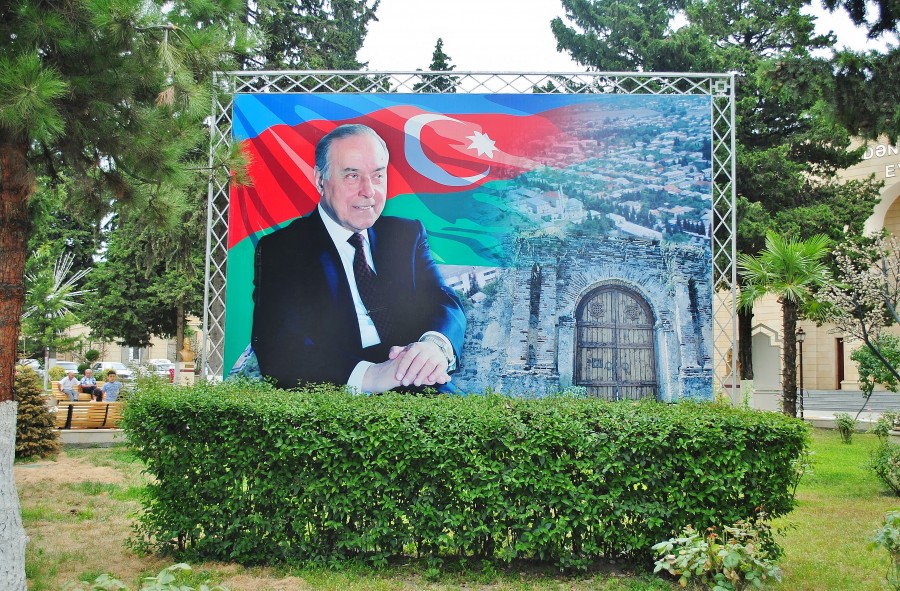
Heydar Aliyev – the communist president of Azerbaijan who lost the war with Armenia and led Azerbaijan to poverty. Nevertheless, the cult of personality in Azerbaijan continues to this day.
After dropping my luggage, I went sightseeing. First, I took a few photos of the “antique” cars and then I walked through the center, passed the mast with the big Azerbaijani flag and stopped by the mosque. Walking up the road, after about 10 minutes, I reached a row of shops and a green square where I sat down for tea. The police were very interested in where I came from, so I said that I was only a tourist. In fact, I was here mainly to see the ruins of an Armenian church that was intentionally hidden behind the houses. Due to political reasons, this church has little chance of restoration, even though it would be the city’s biggest attraction.
In the area there were also defensive walls of the fortress, which in my opinion look too new to be a real attraction. I walked up the high stairs, turned right and after about 5 minutes I got to Heydar Parks. There were several carousels, drinks shops and of course a statue of Heydar Aliyev in front of which I took pictures of local girls. I also noticed that in such a small town there were many posters of the late communist president Heydar Aliyev, which proves the great cult of the individual. Besides, in Georgia the sight of a tourist was common, while in Azerbaijan people paid more attention to me. Fortunately, my Russian is so good that I was able to do it perfectly well.
I spent the evening in a teahouse where I spoke Russian with city men. I found out that living in Azerbaijan is very difficult because 1 manate is equal to 1 euro, while the average salary is only 150-200 manat. Then I went to my ruined room and was happy to enter my new country. I also realized that I was actually lucky to miss the last bus. Zaqatala was a very good experience.
Transportation from Zaqatala to Seki
I only paid for 2 mails and the drive lasted 2 hours. Then from the area around Seki Station, my local route number 11 got to the caravanserai area.
Seki
Seki is a small town surrounded by green hills that boasts a rich history and art. Still, I don’t advise you to expect many tourists here. I was the only one. After reaching the bus station, I stopped for tea served in Turkish cups and then took bus number 11 up to the caravanserai. Zarzymałem at the hotel Karavansaray, which is a historical building that has been converted into a hotel. It is a typical stone caravanserai with traditional arches and a square with many flowers. This hotel is a show building of Seki and even if someone is not staying here, it is worth coming for tea to get a bit of history and beautiful art. Outside there are a row of souvenir shops and halva and nut workshops. Two parts of the street are separated from each other by a channel in which, unfortunately, there was no water for a long time because the plants on the bottom looked strong and dry.
The entire area of the Old Town downhill from the Caravanserai Hotel is attractive in terms of old architecture, and there is also a 19th century mosque and park at the end. I also noticed that people were nice to me, they looked for contact and were clearly interested where I came from. There are not many tourists in Azerbaijan, so a visitor to their country is an event. I sat down on one of the squares where the peanut seller offered me sunflower seeds, I was at the street shoemaker and talked to the boys who were making fun of me. It was nice, but for one of the main tourist centers, it was also very quiet and depopulated.
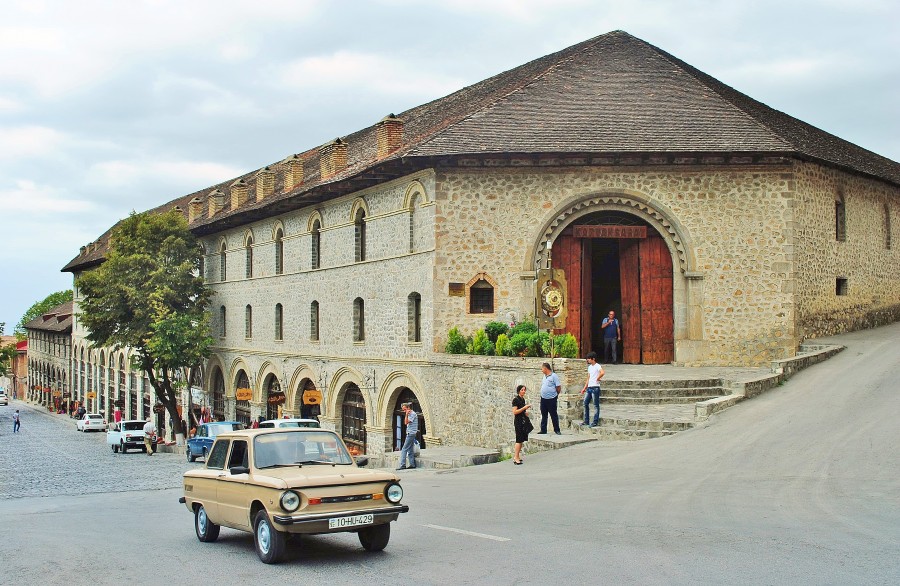
Traffic in Seki. Azerbaijan.
I stayed with a private host because only he offered me the price of 12 manat with breakfast, which compared to 20 manat per hotel was a very good offer. A passerby who just wanted to help a tourist helped me find this place. In Azerbaijan it is so good that someone can help, and not like in India where “help” means fraud or robbery. Of course, there was a poster of Heydar Aliyev in the center as in Azerbaijan the cult of the late president is evident.
Then I went up to the ramparts where there was the famous Xan Saraya Palace, several museums and a gallery. This part of the city is by definition the biggest attraction for tourists, although I found it average. After entering the stone gate, first I went to the shops on the right where you could buy paintings, carpets and many ornaments for women and souvenirs. For connoisseurs of souvenirs, I recommend, for example, a woven carpet with the contours of Azerbaijan or a stained glass window made of colored glass made without the use of glue or nails. On the other side of the street there were museums where I was shown and where the history related to some objects was explained to me in detail.
First, I was in the Ethnographic Museum, where there was a part devoted to animals living in the area, there was also a part about World War II and the conflict in Karabakh, and of course each of these stories was told in the way I expected. First of all, despite the occupation of Azerebaijan, the Soviet Union played the role of a savior and Stalin played the role of a good uncle. It was also impossible not to notice the racial and cultural closeness of Turkey to Azerbaijan, which was confirmed by several paintings and carpets depicting Ataturk. During my trip, the Azeris themselves often said that Turkey and Azerbaijan are two brothers, although I also see a “brotherhood” based on common interest. There was also a local television inside, so by the way they made an interview with me, which they then had to publish on YouTube. It was also interesting that the museum was empty but as many as 8 women worked in it. These ladies sat outside, offered me tea and we talked a bit about life in Azerbaijan and Europe.
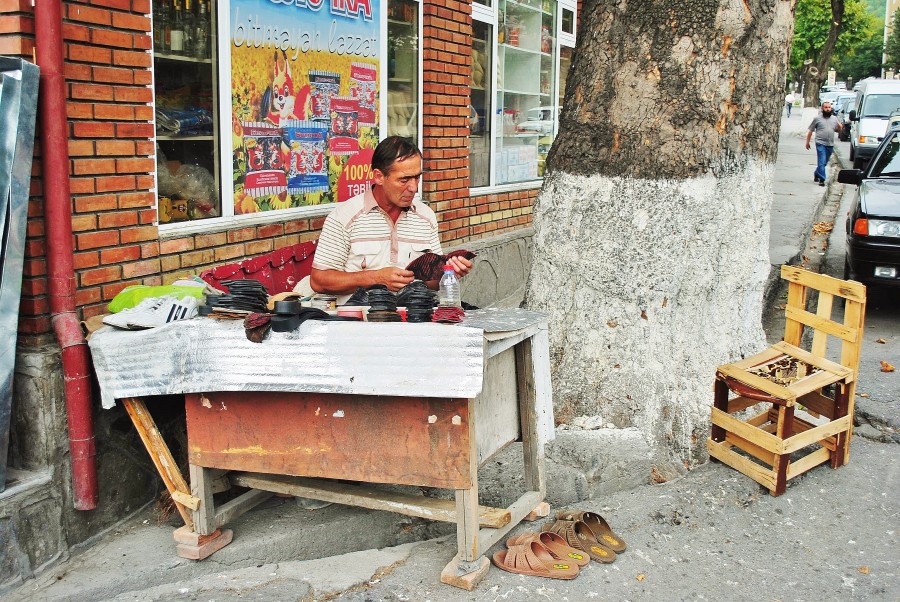
Street shoemaker in Seki. Azerbaijan.
On the other side of the street there was a nineteenth-century church, which now houses the Art Gallery. It is a collection of armor, plates and local products, but I only stood in the aisle to see one small room of exhibits and decided that it was not a museum worth the money. Sebak’s studio was more interesting, where glass and wooden stained-glass windows were made. Their production requires great patience and precision because the craftsmanship of their production consists in inserting small slides into wooden wedges to then give them geometric, matching shapes. At the end, I also went to Xan Saraya, which is the Khan’s Palace, completed in 1762. The property is situated in a rose garden with a pond and a massive, huge tree. This palace is primarily a mosaic show that I described earlier and paintings on the walls. Xan Sarayi is definitely impressive and in terms of art, I recommend it the most, despite the fact that the vivid colors even beat the eyes.
I believe that Seki is a good experience for a traveler and it is very conveniently located on the straight road to Baku.
Transport from Seki to Lahic
With the number 11 marshrutka I got from the caravanserai area to the bus station. Then, after about 2 hours of driving and for only 2 manatees, I reached the suburbs of Ismayili. Then I crossed the road and waited to hitchhike en route to Baku. After a short time, a car stopped and took me to the fork in the road on Lahic. Unfortunately, here I was waiting on a very rarely traveled road, although I was lucky anyway because after half an hour a young boy, driving his 40-year-old Uazem straight to Lahice, stopped. He removed his garbage from the front seat and let me in. The road was beautiful because it led through beautiful mountains and a picturesque canyon. (It is 20 km from the main road to Lahic and transport is necessary).
Lahic
Lahic is a picturesque mountain village and one of the best places in Azerbaijan to try rural life. The craftsmanship of local craftsmen is the production of copper utensils and other everyday objects, which can be admired in one of the many workshops. There are also many souvenir shops on the main street and local hosts open their homes to tourists and offer hiking and horseback riding tours in the mountains. The center of Lahic itself is so small that you can walk it in half an hour but it took me much longer because I was in a workshop, of course I was in a tea room and I bought a few spices. One host offered me hospitality for 15 manat with meals, but I had a different plan.
I left my luggage in the store, took only what was necessary and went on a lonely hike in the mountains. First, I made my way up the river to the waterfall and it was an adventure to observe nature and enjoy the blessed silence. I walked through the boulders scattered irregularly on the river and jumped from one stone to the other. I must also admit that the waterfall itself was energetic but very small and did not resemble those from Laos, big and blue. From the waterfall I came back a bit the same way and then started climbing up the hill. My trail was very different depending on the place. Once the approach was gentle and it was only a walk on a grassy clearing, while other times I was walking through the brushwood, sliding on the rocks and tearing through the dense thickets. The views were changing all the time and with the passing hours I was admiring the new landscapes and I was more and more pleased with myself but also tired.
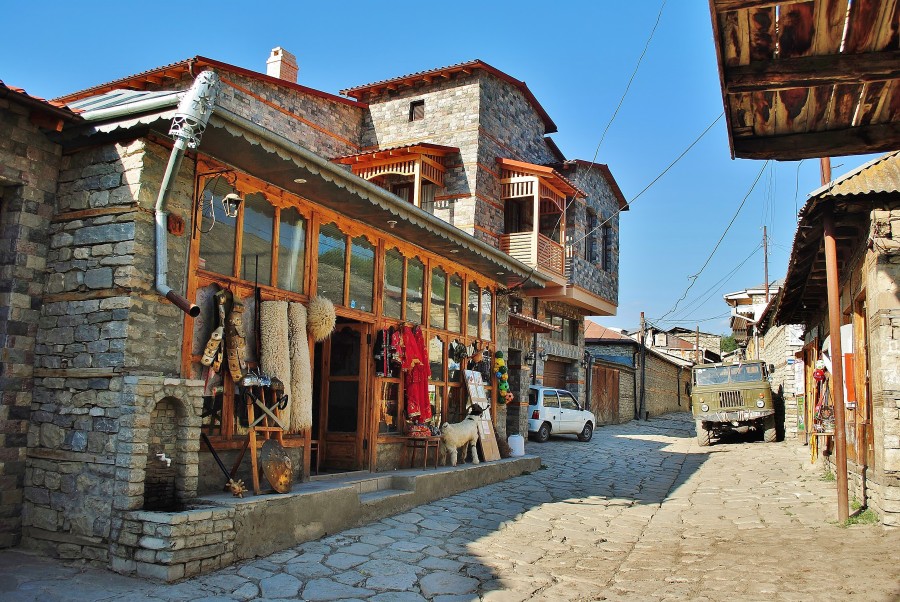
I recommend Lahic and its nature. For those who have room in a backpack, it is also a great place to buy copper dishes and see the rural life of Azerbaijan.
My initial plan was to reach the very ruined Niyal Qalasi fortress but night was falling. So I looked for a proper place to put up a tent and then, in complete darkness, I gathered some firewood and started a fire. The fire guaranteed deterrence of animals, but also an extension of my attractions that day. As soon as the fire burned out, I lay down in my tent on the cold ground. Unfortunately, I didn’t sleep well because I didn’t even have the basics of luxury and compared to many nights spent in the mountains, deserts and steppes, I think this one was one of the least pleasant. It is to blame for the fact that I never want to carry too much equipment. In the morning I folded my tent and went down to Lahic. Despite the hard and cold night, I felt great and was ready for action once again.
Transport from Lahic to Baku
After leaving Lahice, I was lucky because I immediately hitchhiked to the main road and as before, my 20 km was beautiful because it led through picturesque mountains. After reaching the route, the first hitchhiking wanted 10 manat, so I thanked him and the second one gave me a lift for about 2 hours straight to Baku for free. What’s more, I was so lucky that the driver gave me another 5 manat for dinner because I probably looked poor.
I suspect that a marshrutka from Ismayili to Baku would cost about 4-5 manat and a shared taxi about 10 manat, depending on the arrangement. I covered almost the whole of Azerbaijan for free.
Baku
(Description of the city, suspected espionage, interesting conversations in the hotel and on the street that told me a lot about the local dictatorship.)
Baku is in my opinion a very nice and rapidly changing city. It is a combination of the post-Soviet past with the attractive walls of the Old Town and “glass” towers. You can also see that Baku is a monument of money because its new promenade and the pampered Old Town have undergone a very expensive plastic surgery. Baku offers good cuisine, history and souvenirs related to Azerbaijani culture (carpets, copper dishes and others). Walking along the streets of the Old Town and passing by the desert-colored mosques in the distance, we also see three sloping glass skyscrapers and attractive buildings. (By the way, the only ugly building is the president’s administration building, which is located in a communist rectangular block, and I think it’s even better that it cannot be photographed).
Baku’s social center is Bulvar, a promenade on the Caspian Sea, on one side of which there are fountains and exotic plants. It is a very pleasant, quiet place in the most famous part of the city that leads to a tall mast with a huge Azerbaijani flag and a cemetery and monument high above the city. I also noticed that, contrary to the rules of Islam, young couples in Azerbaijan hold hands and hug each other on the benches.

Flaming Towers, which are tall glass skyscrapers designed to resemble flames. These objects are among the greatest architectural achievements of modern Azerbaijan.
After coming to Baku, I first tried Azerbaijani kebabs with aryan but I was not delighted. In Turkey or the Emirates, they give a real kebab, while in Azerbaijan it is a huge roll, a lot of sauce and meat as a medicine. Then I tried to find a hotel, but unfortunately I had nothing for sure, that’s why I took the metro to the train station because it was supposed to be a very cheap hostel. My journey with a big backpack in the heat was very unpleasant, although it was even worse when the information told me that unfortunately they had already closed it. Fortunately, I was advised to go to the Naftalan Hotel in the Moncin Bazar district. I took the number 14 bus there and got off at the last stop. Here the night cost me only 10 manat which is very cheap compared to the 40-50 manat in the center.
It was a pleasant and certainly the cheapest hostel in Baku and guests had a little party every night. Citizens of the entire former Soviet Union stayed here, including from Uzbekistan which I know very well. They gave me food and we also had a lot of political talks about Armenia, Russia and, of course, Nagorno-Karabakh. However, I noticed that they did not trust me and one of the comments that stuck in my memory was; “We don’t know who you are, so we’ll keep some things to ourselves,” and they started laughing. They spoke very carefully about Russia and their president, and allowed full freedom of speech only when there was a topic of Armenia and Nagorno-Karabakh. It told me a lot about Azerbaijan, about the dictatorship and about the worship of the late President Aliyev, whose paintings were also in the hotel. The manager also asked me a couple of times how many more I was going to stay.
I traveled around Baku by buses, which is very well organized there, and from time to time I also got off at various stops for tea. I was sitting outside on a small chair at a low table and the tea maker served new drinks. In this way, I referred to various topics and so, obviously starting with the topic of money and work, we quickly moved on to discussing the case of Armenia and Karabakh. Another topic was wages in Azerbaijan. The bus driver complained to me that he was earning only a starvation salary of 150 manat per month, which is the equivalent of 150 euros, and the president probably earns 20,000 euros a month.
For some reason in Azerejjan there is exactly the same situation that I experienced in China. In China, hardly anyone agrees with Mao Zedong, and even the Chinese government is openly talking about his mistakes, but for some reason the Chinese do not say a bad word to him. In Azerbaijan, people are unhappy, poor and unemployed, but no one wants to comment on the president and his father Heydar Aliyev, who lost the war with Armenia and led the Azeris to poverty. I think the people of Azerbaijan need foreign spy planes to throw tons of newspapers on the streets of the country called “truth” and “don’t be afraid to fight for yours”, although I could also say the same about any European country and the United States.

Government House in Baku, Azerbaijan.
For a few days Baku was my base and therefore I had enough time to see the whole city and organize some excursions outside. For the first two days I was going to Bulvar, a promenade on the Caspian Sea. It is also the place where the Old Town begins and where there are places attractive for tourists. Bulvar itself is very pleasant at any time of the day. On the opposite side of the sea, many exotic plants are planted and the promenade is often a fashion show where women come to present themselves in the company of their men. Bulvar is also a good vantage point for three glass skyscrapers on the top that change colors after sunset, but for me it is above all an attractive and peaceful place to which I have returned many times. There are also many interesting government buildings on the main street, many of which are very impressive and the roads are run by the same taxis that are used in London. Attention should also be paid to the yellow opera house, city hall, carpet museum, manuscript museum and some lovely squares with fountains. There are also many desert-colored mosques and two churches in the same area. I saw all these objects, but I did not always go inside because I was not interested in the eighteenth century Korans, frescoes in churches that I recently saw so much in Georgia, or, for example, carpets that I was supposed to see hundreds in Iran in 3 weeks. The very impression of Baku was more important to me.
At the beginning of the Old Town (Icheri Sheher) there is a Qm Qalasi tower built in the twelfth century, whose destiny is not quite known. I admit that the mystery of this object, which is additionally surrounded by old-style buildings and vegetation, I liked and are also associated with interesting legends. Historians think that this very massive, 8 storey building served as a defensive wall or observation tower or as an astronomical observatory, although there is also a story of unhappy love. This property appears on all postcards of the Old Town. Below you will find shops with Azerbaijani products (such as armor, carpets, jugs, various souvenirs) and below the square with statues and lower rows of desert shops. Each of them has an exhibition of carpets and handmade copper jugs (probably from Lahic where I was before). Going through the Old Town and stopping at the carpenters from time to time, I reached the walls , and many decorations like the old cannon. Walking through winding alleys I first saw the Cuma mosque and another important point was the Shirvanshahs Palace . It is a 15th century complex of many buildings, which was nicely restored in 2003. There are, among others, the apartments and the Keyqybad mosque leading to the Dervish mausoleum. The whole complex is on two levels and is rich in sculptures.
From there I headed up to the newer part of town with the sad face of war Sahidler Xibayani. I walked up the stairs sometimes passing the terrestrial line and the rich-looking houses. It was clear that only the thickest wallets lived in this part of town. The first object worth mentioning is the Turkish mosque and the cemetery of people from many wars and many nations fighting in Azerbaijan. Further on the large square there is a monument of eternal fire to the memory of the fallen who is today one of the symbols of Baku. In turn, turning right behind the Turkish mosque and then once again down the white stairs in full glory you can admire the Flaming Towers, or tall glass towers to remind the flames. Strolling down the boulevard in the evening, you can see that they are illuminated in the color of Azerbaijani flag, which is an additional charm of this city. As I climbed from the top, I sat down for a moment on the wall from which I had a very good view of the entire port, the Caspian Sea and the high mast with the flag of Azerbaijan. At the end I walked the boulevard and late in the evening I returned by bus to the hotel where one of the guests played the guitar.
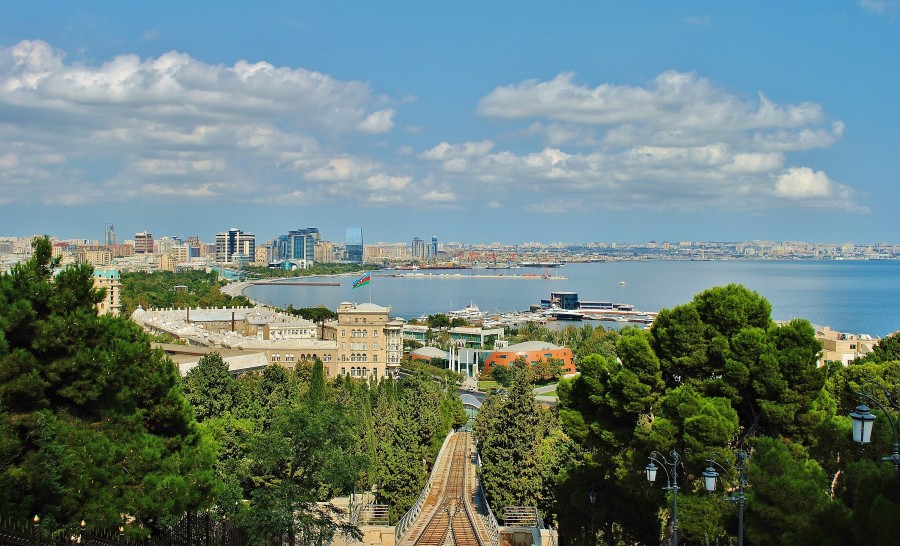
Top view of Baku and the Caspian Sea. Azerbaijan.
Day trip outside of Baku
(I also describe the exact transport from place to place and I believe that my plan can be used as an accurate guide)
After a few days in Baku I went to see other interesting things in the area and it was another great adventure. From the hotel in Moncin Bazar I took a bus going to Narimanow Metro Station. On the margins of the square near Narimanov Station there is a nice center where you can dine in the evening and have fun in the merry-go-round. From Narimanov station I got onto the bus number 184 and after about 0.5h I was at the final stop 5 minutes walk across the tracks from the Atesgah Fire Temple on Peninsula Abseron . The Temple of Fire is one of the most important monuments of Azerbaijan and was built in the 18th century by the followers of Shiva. It is also important that the Temple of Fire is one of the most sacred for the followers of the extermination. The entire facility is desert-colored and consists of a small temple in which eternal fire burns (thanks to the continuous supply of gas) and around them are the chambers and there are models of antique zarobastians in their daily work. I spent about an hour in this facility because I like better feel the atmosphere of the place and I have to admit that moving around the wooden surface and exploring all the chambers is occupying. I highly recommend the Atesgah Temple. I only paid 2 manatees for the entrance.
Then I went back to the dusty square where the buses were and I got to number 184. When I was about 20 minutes away from the post-Soviet plate houses and the wilderness, I got to the suburb of Baku where I had to go to bus number 207. This bus was long because it was behind the center of Baku and beyond Bulvar and a great mast with the flag of Azerbaijan. On my way to the left was the Caspian Sea and the James Bond oil field , as there were shooting pictures for The World is not enough. It is rather uninteresting, stinking place driving the economy of Azerbaijan but on the way back and so I got off on some pictures.Immediately afterwards, I saw a new mosque in every inch and then got off at the last stop of the name ‘dwaccat’. Then I got on bus number 195 and traveled about 45 minutes through the sandy wastes. I reached Qobustan , a dirty, poor and uninteresting hole separated from the road by a high concrete wall. I did a little shop shopping here and I was lucky enough to find a tascher who agreed to take me to all three places for 15 manat, though he wanted 25. After a while we got to the Petroglyphs and the museum.

Mud volcanoes in Qobustan, near Baku. Azerbaijan.
Petroglyphs are carved mosaics in rocks dating from the Stone Age. In those days, the Caspian Sea was about 80m higher, which means that primitive people lived in caves just above the water and in the hunt for a lot of interesting shapes. These included animals, people and the boat. The entire area around the petroglyphs is a semi-desert area decorated with plant robes and large boulders. This place is most recommended, and not only because of the original art itself, but also because of the surrounding great rocks, grottos and vegetation and the view of the blue sea. There is also a sign that you should be careful about the snakes, but in my case it was a nice addition because I hold some strangers in the house and trained with the venom before. I was also here in a nicely prepared and worth every manatee museum, where the figures of the stone age were shattered during daily activities, animals living in these areas and weapons and tools found in the petroglyphs.
Then we went to the nearby Roman Grafitti (2km from the petroglyphs) but unfortunately this part was not nicely exposed. I saw only a huge boulder fenced with a grid inscribed with Roman inscriptions. It is the easternmost discovered monument of this kind and comes from the 1st century probability. Then I went with a cab driver to a roadside tea shop for only 1 manatee.We sat in the shade, we were resting, and I watched the trucks. Then we went through desert wastes to the mud volcanoes , which turned out to be a completely new experience for me. Petroglyphs have already been seen in Kyrgyzstan and temples are in every country, but volcanoes of this kind are very interesting not only for geologists. It is a network of very small volcanoes that explode, bubbly and spit on a beige mass, and at the top there is a couple rising. I was on it, I was waiting for the best explosions and I admired the beautiful landscape.

Ateshgah – The Fire Temple on Abseron Peninsula, near Baku. Azerbaijan.
The Dasgil hill on which the volcanoes are located would probably have been completely destroyed if not for this geological phenomena. The whole is in the desert, and the Caspian Sea is visible from the volcanoes. After all, the driver drove me to Qobustan and from there I got on the bus and for only 20 qepik I reached the beach of Sixova . After a hot, hard and very adventurous day, I finally dived in the tranquil Caspian Sea. It was very nice and at the beginning of September the sea was still at 26 ° C.
Then my return to the cheap hotel at Moncin Bazar in Baku was also very interesting. From the beach I hitched a hitch into a new, very nice mosque overlooking the sea and oil fields of James Bond. Then I grabbed another hitch which I got to the Bulvar area and strolled for the last time in the streets of the Old Town, in some way saying goodbye to the beautiful capital of Azerbaijan. Then take bus number 14 back to the hotel.
Transport from Baku to Quba
Getting to Samaxinka bus station was not easy and it took me some time but it was ok. I had to go there with three buses starting from Narimanov station and I was successful because the people were helpful and told me where I should get off. Sometimes I had to go a bit, but it was another transport adventure in Baku. Taxi is unfortunately expensive. The transport from Baku to Quby cost 4 manas and took over 3h but sometimes it may take longer or shorter.
Quba
When I got to the bus station in Qubie, I looked around and quickly realized that the place was only a small, unattractive transport hole on the way to Xinaliq. So I went to the pub, bought the grapes at the bazaar and asked one of the many unemployed taxi drivers how I could get there. Unfortunately to Xinaliq there was no cheap bus because it was not a busy direction so a taxi was the only option. Everyone said that the transport costs 40 manat but there was a taxi driver who offered me 20 manat.
In Qubie I was obviously 2 times since I had to go back to Baku and take the opportunity to see it and this small town. I was in the tea room where apart from Turkish tea I was given a dolphin or Azerbaijani delicacies wrapped in grape leaves. Also tea and vegetables for only 3 manatees. Then I walked through the hole, reminding myself of the bus station that was hugged by a mine and shuffled around. Taxi drivers posed for photos and were eager to talk about their poor, poor lives. I was also in a fairyland which in my opinion despite some carousels in the end was not so cheerful. I met a 77-year-old grandfather who told me that the best time in his life was when he served in the Red Army in Murmansk and thought that if the Soviet Union were still there he would still feel like a 27 year old. I think Quba has its tragic side and it’s a gray, bleak city where life does not spoil anyone.

Azerbaijani man.
Transportation from Quba to Xinaliq
The road to Xinaliq led through beautiful mountain views, a canyon covered with greenery and a view of the river below. The more advance we made, the mountains were more beautiful and the open spaces were the home of the scavenging sheep. The climate was getting colder but it was a good prelude to my new, beautiful adventure near Dagestan.
The taxi journey took about 40 minutes. I remind you that it is very important to bargain for a good price because taxi drivers know that Xinaliq does not run buses and try to pull as much as they can. I paid 20 manat but it was a price bordering on miracle. I think 4 people in the taxi should pay a maximum of 40 manat per one way back and you can try hitchhiking alone. Taxi drivers will also pretend that they do not know about the new road to Xinaliq and therefore will tell fairy tales of uneven route and higher fuel consumption.
Xinaliq (Khinalug)
Xinaliq is one of the most beautiful and touristic places in Azerbaijan. It is the mountain pearl of the Caucasus, which dates back to 5000 years, and the village itself is the highest located in Azerbaijan, and one of the most secluded and highest located in the entire Caucasus. People living in Xinaliq speak their own language “khinalug” although they also speak Azerbaijani and Russian. The village of Xinaliq is lovely and the vast terrain from any of the tops guarantees great views of the Caucasus. The village, on the other hand, is built of stone in such a way that it seems that one house is built on top of another.
I was here, inter alia, in the museum, but the greatest pleasure was walking along the narrow alleys of the village on all its levels. Once I also sat outside and the local women offered me tea and of course we had a conversation. I saw people doing their daily activities like shoeing a horse, feeding ducks and donkey transport. In the evening, despite the dark and cold night, Xinaliq was very much alive. People had a party in the common room and the children were very interested in the only tourist in the village and wanted to see my photos.
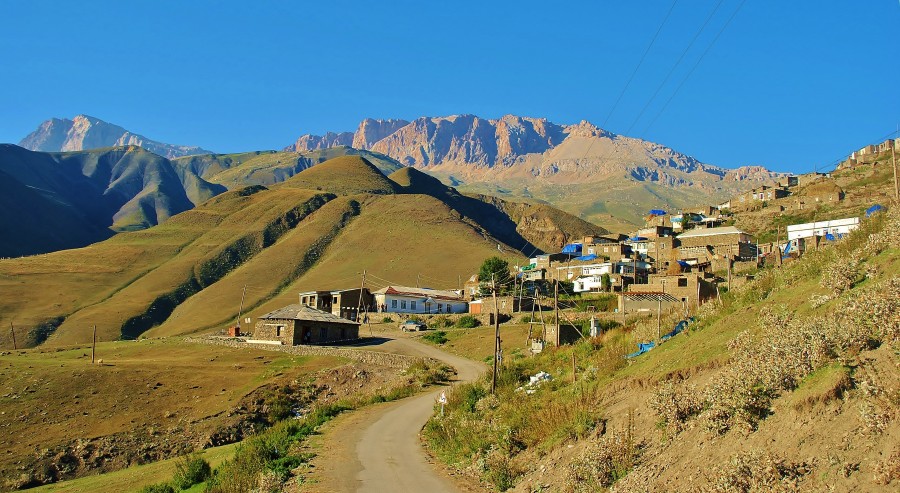
Xinaliq village is in my opinion a special place. It is built of stones and situated among the green pastures, and mountains of the Caucasus. Xinaliq was built around 5,000 years ago.
When I came to Xinaliq I had no place to stay as there is no official hotel. Some locals wanted 25 manat for accommodation with meals but one host allowed me to stay for only 5 manat and the next day the women gave me something to snack on. Goodbye apart from money I bought children candy. For two full days I wandered around Xinaliq and its surroundings. I climbed up to a couple of mountains, watched rural life, and gorgeous green valleys and river in the canyon. It was also interesting for me to feed sheep and donkeys around the river, though I was also witnessing how the shepherds loaded the rams on the upstairs car and how nicely they convinced them with their whips. I also loved it. Generally my whole stay in Xinaliq and its surroundings I found to be good and I would recommend both the historic village and its people as well as the scenic views around. I think Xinaliq is a mandatory part of the trip to Azerbaijan.
Transport from Xinaliq to Baku
The hardest part of my transport was the course from Xinaliq to Quba. First I had to go through a piece and then I managed to catch a hitchhiking for only 3km. Unfortunately, it began to rain and I was lucky to have a place to hide. But it was not easy because I was standing in the rain in the strong wind for about an hour until finally a 30-year-old Uaz who had taken me another 30km. For this part of the journey I had to pay 5 manat and when I think about it now I think I was so lucky that I had such a choice. There is no formal transportation in Quba – Xinaliq and the weather is variable and it is a very depopulated section. Last 7-10km I drove old Moscow for free. After getting to the station in Qubie, I came to town for a few hours and then drove from the city center to another railway station, of course passing the next monument of Heydar Aliyeva.Here, I got on the bus in which Poland would furrorę lovers of old junk, which I also am. I paid for 3h drive 4 manatees.
Transport from Baku to the Georgian border
Good bus ride passed pleasantly. I paid 10 manat for 10h while driving on the route the driver deceiving because one girl paid 12 manat. However, it is very important to have a good plan your trip with Krasny Bridge border. There are buses going from here directly to Tbilisi, the Marneuli or to limit or Georgian – Armenian.
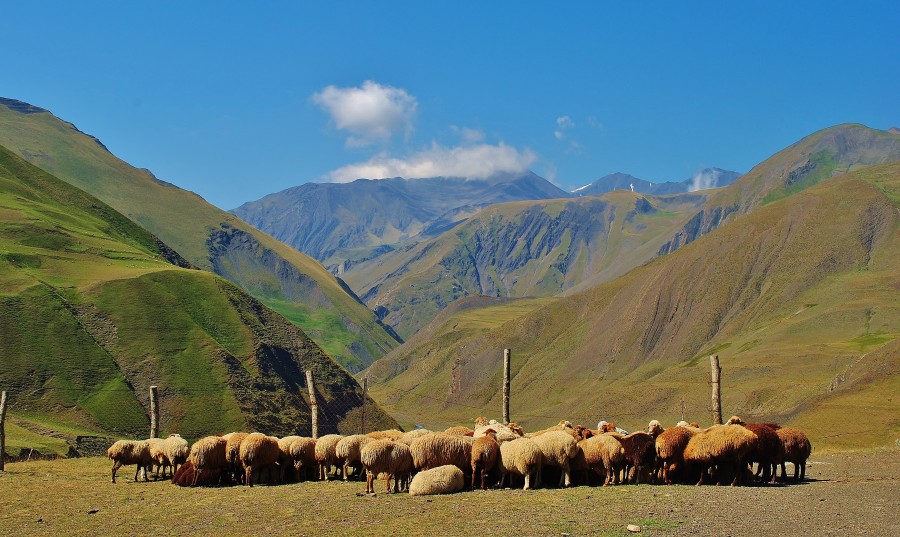
Sheep grazing on green pastures near the village of Xinaliq. Azerbaijan.
Summary of Azerbaijan
Azerbaijan turned out to be my another interesting adventure and appreciate the fact that I was able to get there. Due to the difficulty of getting a visa and its high price not everyone takes the effort but I assure you it is worth it. Country defends itself against mass tourism which makes it even more interesting. In addition to the beautiful city of Baku and interesting neighborhoods Qobustan most liked the mountainous areas near the Lahic and of course Xinaliq, but I assure you that in so exotic in their own way the country as Azerbaijan all around, starting with the culture and a good approach people to tourists will surely be a memorial for lifetime. I would definitely recommend Azerbaijan.



































